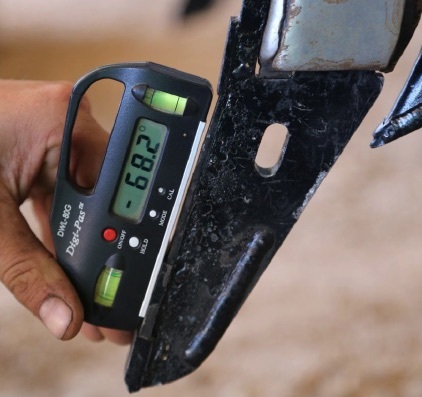Ag Tech Sunday - Why Ag Tech startups should push for farmer-focused targets
- By: "Farm Tender" News
- Ag Company News
- Oct 13, 2019
- 707 views
- Share

This article is bought to you by Warrick Hay & Grain and Air Seeder Consulting Services.
By Walt Duflock
As part of a project for one of the larger berry producers, I spent a lot of time the past year working with strawberry harvesting startups. As you can imagine, there are some big technology challenges with strawberry harvesting. First, you need great visioning technology to identify which strawberries are ready to harvest and which are not. Second, you need a great strawberry picking robot arm to pick the strawberries that the visioning technology identified as ready to pick. Third, you need a robot mechanism that puts the strawberries somewhere after they are harvested (somewhere safe where they won't get damaged). Fourth, you need to build the robot to deliver the harvesting capabilities at a set of speed and efficiency targets so that manual harvest labor can be fully replaced by automated harvesting.
Ad- Warrick Hay & Grain - Professional Grain and Hay Storage - Ad
Ad - Get your Seeder set up the right way. Contact Air Seeder Consulting Services and have your Seeder running right before you start - Ad
No, wait, strike that last one. In fact, it turns out that if you are a strawberry harvest startup, you should actually argue for a change away from speed and efficiency targets to the target that matters most - how much will it cost to robot harvest a kilogram (kg) of strawberries. This changes the focus from a "how good is the technology" discussion to a "we can use this technology to replace labor if it costs this much" discussion, which is a lot more useful for both sides. It's more useful for startups because it gets robots in the field faster, and it's more useful for farmers because it allows them to focus on their economics and labor risk, not the quality of the technology.

Advanced Farm just raised $7.5 M in venture capital (Fall 2019)
The "how good is the technology" model the berry producer was using evaluated startups based on two key variables: (1) how fast they were able to harvest strawberries (with adjustments for seasonality and regulatory changes to costs like overtime and breaks); and (2) how many of the strawberries that were ready to harvest were they actually able to harvest. But after a lot of discussion, we realized that the model underweighted the impact that two factors are expected to have on agricultural production: (1) increase in labor costs; and (2) lack of labor availability.
How bad is the rise in labor costs forecast go get? Well at the Forbes AgTech Summit in Salinas one of the executives from Driscoll's Berries gave a presentation that included a slide that said that over the next 5 years the expectation is that labor costs will go up by 70%. Naturally, this raised a few eyebrows. Even in a food segment that can be as profitable as strawberries, when the single largest cost is harvest labor and it's forecast to go up by 70% in 5 years and no reasonable alternative is immediately visible, that is a big problem. The more interesting part is that the cost increase may not be the biggest problem. No, the biggest problem is likely to be the decreasing availability of labor.
Ad- Warrick Hay & Grain - Professional Grain and Hay Storage - Ad
Ad - Get your Seeder set up the right way. Contact Air Seeder Consulting Services and have your Seeder running right before you start - Ad
Here's why availability is a bigger problem. If a grower's costs go up, he has some negotiating options with the people on the supply chain. The negotiations may not go well, but those are economic outcomes the supply chain is used to and can usually manage. On the other hand, if a field of strawberries go unharvested, there is no negotiation to be completed. It's the worst possible outcome for the farmer. All of the time and money on field preparation, planting, growing, and getting ready to harvest is wasted. At this point, with many farming operations being generational family businesses, many farmers start to question the wisdom of their ancestors and maybe of even owning the farm at that exact moment. So cost increases are bad, but not harvesting is defcon 5 (and yes, I'm aware that defcon 5's official definition is "least severe" and that defcon 1 is "most severe" but at some point common usage resulted in those definitions flipping in usage, so I'm going with defcon 5 for this post) stuff for farmers. There are very few things that get farmers to consider changing behavior faster than defcon 5 stuff. Sometimes it causes them to even listen to startup pitches.

This excellent Cowpokes cartoon could just as easily be a farmer looking out at an unharvested field. This is what gets farmer's kids thinking about off-farm opportunities (or so I've heard …)
Which is exactly why AgTech startups need to ready when this happens, and why it's good to know what constitutes defcon 5 stuff. You need to be ready to articulate exactly why your solution can help avoid the defcon 5 situation and help make sure it does not happen again. And it is inbounds to mention the situation even when the farmer is not in it at the moment, because the fear of it will sometimes get you an audience. It also helps the farmer know that you understand the seriousness of the situation, which improves your credibility.
Ad- Warrick Hay & Grain - Professional Grain and Hay Storage - Ad
Ad - Get your Seeder set up the right way. Contact Air Seeder Consulting Services and have your Seeder running right before you start - Ad
So how do you, the entrepreneurial startup founder, help the farmer at this point? Well, you've already got a solution that can help and you're ready to do a field test with the farmer. The next step would be to offer a per-kg price range for harvesting and negotiate a field test with exact dates and the exact requirements from the farmer (in terms of people, time, and money) to execute the test. By offering a service-based solution at a price per kg, the farmer gets to decide how much of your solution to use and how much to use for manual labor to complete the harvest without worrying about efficiency and speed of the machine. It's an economic decision, which is what startups and farmers should want. And that transition from a technical to an economic decision is exactly why both sides should welcome the transition to yield-based pricing models and subscription services. It aligns the goals most closely between startups and farmers while reducing the farmer's commitment from an equipment purchase to a service commitment.
I will close by suggesting that every robotic harvester (and many other AgTech startups that build equipment and include it in their solution) should strongly consider three strategic recommendations. First, you should include some type of "as a service" offering for your solution at launch (and it should probably be the primary pricing model in many cases). Many farmers are moving away from or at least reducing capital equipment purchases, and offering a subscription style pricing makes the entry price for them a lot lower, which works to your benefit when trying to close a sale. Second, consider per-yield or per-acre pricing as the preferred metric because it takes the discussion away from technical requirements and moves it towards labor replacement. This is the right perspective to discuss with the grower, because that's how they regularly think about their operation (on a cost per acre or yield metric). Third, assume many customers will move towards the as-a-service option and build your financial plan and fundraising targets to replace "sell a few big pieces of iron for lots of money one time up front" with "sell a service for a much lower, but recurring, amount each season." This means less up front revenue and more revenue over time. In a cash burn environment which many early-stage startups find themselves in, this can make a big change in forecasting profitability and necessitating more fundraising before the startup can get to cash-flow positive (which, as we all know, is a great day for any startup). I have seen startups have to adjust fundraising plans and valuations when they realized the as-a-service model was becoming their primary model based on customer feedback. It's a lot easier to make that change earlier than it is later.
By focusing on solving the farmer's problems, startups can actually achieve the rare win-win-win trifecta: (1) farmers get lower-priced solution options and higher service levels from startups; (2) startups get to market quicker because of the improved pricing model and focus on business objectives; and (3) investors and startups get better valuations based on recurring revenue (much more attractive revenue multiples on recurring revenue streams).
Ad- Warrick Hay & Grain - Professional Grain and Hay Storage - Ad
Ad - Get your Seeder set up the right way. Contact Air Seeder Consulting Services and have your Seeder running right before you start - Ad 











Share Ag News Via